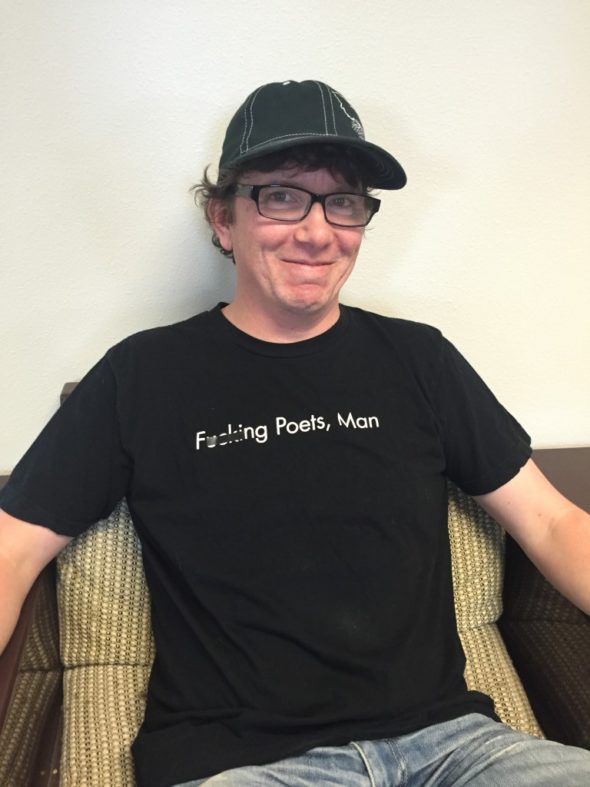
The Barrelhouse staff convening. Photo courtesy of Killian Czuba
Barrelhouse, a nonprofit literary organization, has been using our submissions manager since 2010. In fact, they were one of our very first clients. We spoke to web manager Becky Barnard, art director Killian Czuba, and online editor Erin Fitzgerald about the recent redesign of their website.
Caitlin: Before we get into the juicy bits, what are three things we should know about Barrelhouse?
Becky: (1) To steal a line from our website, Barrelhouse bridges the gap between serious literature and pop culture. (2) We’re a literary journal (also a small press, a podcast, and a provider of writing conferences and online workshops) that was created because the founding editors were talking in a bar about where to place a serious essay about Snoop Dogg. (3) Our editors will arm wrestle you at AWP.
Killian: (1) Some of my favorite Barrelhouse poems have been about Kanye West, and at a recent staff retreat, we spent a lot of time talking about Howard the Duck. (A lot of time.) (2) Becky linked to this above, too, but in case you missed it: the podcast Mike and Tom do — Book Fight! — is awesome, as verified by the 2015 Philly Geek Award for Streaming Media. (Way to go, dudes!) (3) Barrelhouse embodies the spirit of WHYPHY(Warning, there are swears in that link.)
Caitlin: You recently redesigned your website. What was the impetus for the change? Why now?
Becky: We seem to redesign the Barrelhouse website every few years. Technologies change, or the purpose of the site evolves, or (memorably, with one of our WordPress sites) we get a little lax in keeping up with our security patches and the site gets hacked by Ukrainian teenagers, for reasons known only to them.
We moved the site from WordPress to a cloud-based web development platform about two years ago. We liked a lot of that platform, but there was one giant problem – the URLs were messy. I think our URL extensions were something like 30 characters long. That made social media ugly – if we wanted to tweet a URL, we’d have to run it through a shortener like bit.ly, which hurt our SEO and took away from our Barrelhousemag.com brand identity.
Erin went from longtime friend of Barrelhouse and overall cool person to our online editor last winter. She has fantastic, fun ideas for new content, and we needed to share more links as her influence kicked in. Then in the spring, Killian agreed to be our art director. Killian’s responsible for the gorgeous art and the color schemes.
We’re using a banded web design that’s really clean-looking, and moves responsively for mobile devices. Other than a few static pages, most of our content goes into blog posts, that are then tagged and automatically sorted. Hopefully, we’ve made it easier for someone to binge-read all of our Barrelhouse Television Workshop posts, or our online issues.
Caitlin: Barrelhouse seems completely comfortable working in both print & electronic publishing, as well as curating both face-to-face and virtual experiences. You’ve got the print magazine, online publishing, the podcast, workshops, conferences… How does it all fit together?
Erin: When I came aboard, one thing I learned quickly is that the Barrelhouse empire is a very idea-friendly environment. If there’s a great concept making the rounds and you want to run with it, it’s highly likely that you’re going to find support. It all fits together because within each component, there are people who really believe in what they’re doing.
Killian: It seems largely because of the people involved. Have an idea? People think it sounds good? Well, let’s try it!
Caitlin: Did mobile influence the redesign?
Becky: Definitely! Last month, 22% of our overall visitors and 30% of our return visitors were on a mobile device, and those figures will probably go up again next month. We want to increase our online content, and we want to make sure that our users can view it comfortably on any device.
On the home page, I limited each basic category to three items, max. I didn’t want someone to get stuck scrolling through too many blog posts before they got to our conferences, our submissions guidelines, or our store.
Right now, our online content is naturally mobile-friendly – it’s normally just text with an image or two, although the spacing on poetry can sometimes fall victim to a reduced screen size.
Caitlin: Looking forward, what are you most excited about, and how does the new website tie in?
Killian: I’m hoping it will encourage more cross pollination with visual artists. We’re hoping to start accepting comics officially in issue 16 or 17, and I am stoked on that. The indie comics community is such a supportive place, and I think comics creators are in a spot similar to TV creators: they’ve broken free from Sunday Funnies and are riding the high of a tech presence. Patreon, Kickstarter (sorry, Dave, haha), PayPal donations, and the relative ease of creating and selling art prints and self-publishing quality work has made the comics world free in a way that makes the fiction-prose side of my life extremely jealous. Tech + Art = Happy, Paid Artists.
Caitlin: How do you see media evolving? What’s the biggest difference between the media you consumed as kids, versus what’s out there now?
Erin: I’ve always thought of media as the family we all share. Some of my favorite people in the world have been the people I talk to about books, music, television, and movies. And it’s not just about mutual affinity — it’s also about opening doors to shared experiences, and bigger conversations.
What’s out there now is smarter, and more inclusive. There’s a lot more room for both of those things to progress, of course. It’s a challenging and very interesting place to be.
Caitlin: Do you think fiction writers should watch more TV?
Erin: If “more” means season 2 of True Detective, no. But other than that, sure, if that’s what they need to do right by their work. I don’t think a Literature-Must-Abstain-From-Activities-Deemed-Lowbrow attitude has ever been useful. And in an era like this one, it’s useless and outdated.
Killian: I think they should if they like TV. Some people don’t like it, and that’s fine, but TV (and reading scripts–which I highly recommend doing) gets me really excited these days. You’ve got this sweet spot of huge audiences + people hungry for strong storytelling and experimental images. Like comics (sweet, sweet comics. Read all the comics, people!), TV can be hella literary.

Here’s John, very comfortably allowing me to take his picture.
Caitlin: We love your T-shirts. Our CTO, John Brownell, has the one that says “fucking poets, man.” That’s a great shirt. Seriously though, what about those fucking poets? It’s easy to see how prose techniques fit into modern storytelling, but what’s happening with poetry?
Killian: As much as I love to keep up the facade of mutual distaste, the deeper I get into fiction (prose, comics), the more I come to envy poets. You read something like Roberto Bolaño’s 2666 and think: Fucking poets, man. Only a poet could write that book. Have you guys been watching things like Hannibal? Bryan Fuller totally has a poet’s eye. Aside from cross-pollination, I love reading contemporary poets. There’s a lot of play, a lot of politics. Like, Maisha Z Johnson’s No Parachutes to Carry Me Home (my current fave) tears into you so fast, you don’t even realize you’re sitting there, three pages in, ugly crying on the bus. I want more prose that does that.
 Caitlin Stainken is on the Submittable sales team. She has an MFA in fiction from the University of Montana, and she’s an alumnus of the Chicago Neo-Futurists. At 5’4″, she’s the tallest woman in her family.
Caitlin Stainken is on the Submittable sales team. She has an MFA in fiction from the University of Montana, and she’s an alumnus of the Chicago Neo-Futurists. At 5’4″, she’s the tallest woman in her family.
